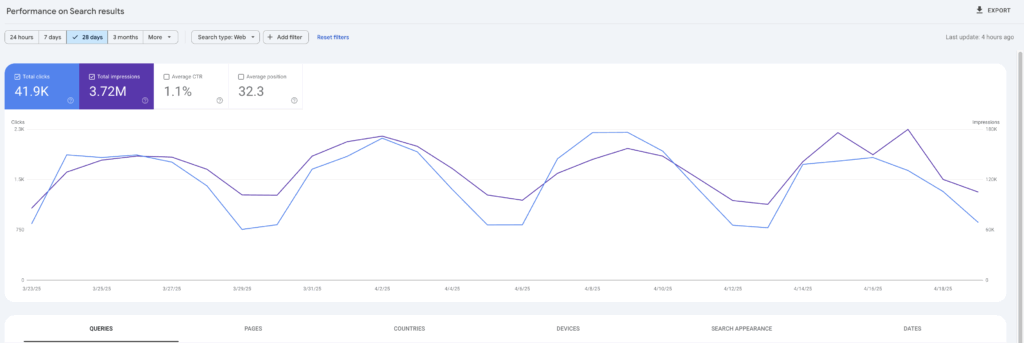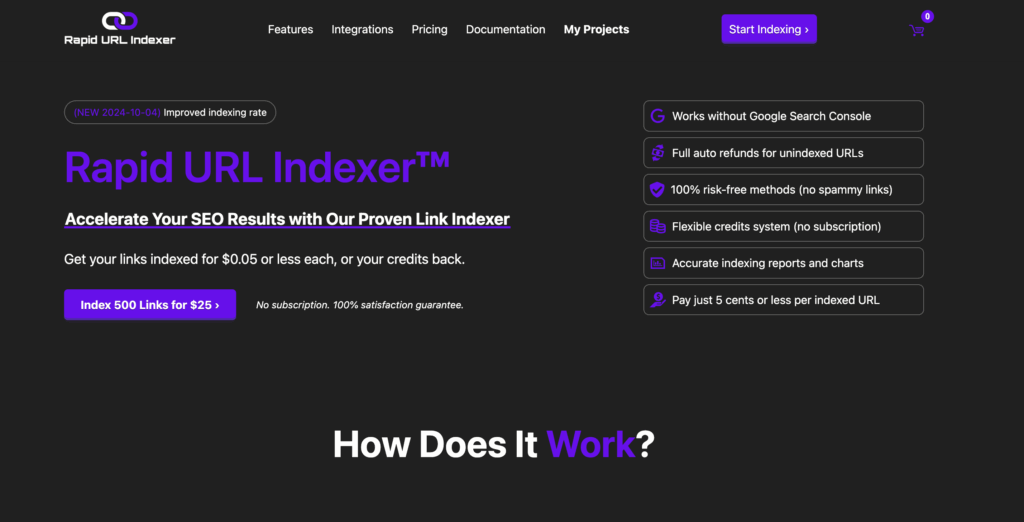Introduction
Picture this, you just released a new piece of timely content, be it a news article, blog, product or service page and to your disappointment Google has not indexed it until three days later.
Did you know that in Google’s helpful content update released in 2022 they prioritize, speed, freshness and people friendly content?
If you are a website owner or SEO professional you may have heard of the Google Search Console (GSC) but what about the “Rapid URL Indexer”?
If you have ever asked yourself the question on “how to get web pages indexed faster” This post was made for you!
In this article by the Cindtoro team we will discuss the differences between both tools, how they work, and give you pros and cons of each.
Come with us and learn everything you need to know about Google Search Console Vs the Rapid URL Indexer and how they can improve your SEO performance.
What are Google Search Console and Rapid URL Indexer?
Google Search Console (GSC)

The Google Search Console is a free tool created by Google that allows webmasters and SEO professionals to read, understand and analyze data about a website from organic search. There are numerous things at your fingertips designed to help you make your website better for search engines and people.
Rapid URL Indexer (RUL)

Rapid URL Indexer (RUL) is a paid tool that helps you index links in bulk. It also helps to speed up the process of getting web pages onto search engines like Google.
The tool is particularly useful for websites that struggle to index their content on a search engine. It can also be used for backlink indexing, and for situations such as fixing backlink penalties where disavowed links need to be re-crawled.
how does rapid url indexer work?
The Rapid URL Indexer works by sending your newly created or updated website links directly to search engines like Google for quicker crawling and indexing, instead of having to wait for them to discover it organically. (As they encounter it)
The indexing tool offers features such as API integration, for both Google Sheets and WordPress plugins, as well as bulk submission capabilities (covered above) in order to streamline the process when then helps to increase a websites visibility by ensuring new content is found and ranked faster.
Comparison Breakdown Of Google Search Console VS Rapid URL Indexer
For ease of use here a breakdown table of both the GSC and RUI tools side by side.
| Feature | Google Search Console | Rapid URL Indexer |
|---|
| Cost | Free | Starts at $25 for 500 credits |
| Indexing Speed | 1–7 days (varies) | 1–48 hours (often same-day) |
| Bulk URL Submission | Limited – via sitemap or manual | Supports bulk uploads |
| Search Engine Support | Google only | Google, Bing, Yahoo, and more |
| Analytics & SEO Data | keyword insights, mobile usability, etc. | Indexing only |
| Backlink Monitoring | Yes | No |
| Ease of Use | Moderate requires some SEO knowledge | Very easy simply upload and go |
| Best For | Long-term SEO management | Rapid indexing of new content or large sites |
Use Cases For Faster Indexing Via Rapid URL Indexer
The rapid URL indexer has some advantages over the Google Search Console when it comes to indexing fresh content. Here are some real world examples of who should pick the tools. We’ll include a more general “checklist” below towards the end of the article.
News publishers
Getting pages crawled and indexed is critical for news publishers especially when you are talking about a large volume of content. Fast indexing is the most important element of a publisher’s SEO efforts.
The cindtoro team has real world experience with this because one of our clients publishes 50+ stories per day on commercial real estate news. Delays in indexing means = less page views which = less ad revenue.
In addition to lost ad revenue it is nearly impossible to rank your website on Google News if you are not the first to break a story.
Affiliate marketer / Blogger
Your SEO strategy can be greatly improved by showing up faster in the search results. Ranking #1 on Google matters. Being placed on page one of Google matters. Faster results helps you get more search engine traffic and helps you beat your competition.
Local business owner
As business owners ourselves we understand this use case better than most. Picture this: you just launched a few new services pages and you want them to show up in the search results today. If they don’t show up you lose out on valuable organic traffic. You cannot afford to wait for Google to crawl your website.
“Getting your webpages found by Google as fast as possible and improving your Google crawl budget is an SEO fundamental. It matters especially in the fast paced world of digital marketing. Without an indexing tool you are greatly harming your ability to get things done.” Walter – Cindtoro CEO
Which Tool Offers Better Indexing Speed and Efficiency?
This all depends on your use case. We would advise you to consider what is important to your company prior to making a decision to use either one of the indexing tools.
If you need to get content indexed as fast as possible the Rapid URL Indexer is your best bet.
Of course you can also get your indexing handled by the Google Search Console (GSC) however it does not offer the same speed and efficiency as the RUL.
Pros & Cons Of The Google Search Console and Rapid URL Indexer
Since both tools do sorta the thing we thought it would be a good idea to include the pros and cons of both tools. Later we will dive into additional but important areas as well.
Google Search Console (GSC)
Search Console Pros
- Official and reliable: The GSC is built by Google and connects directly with their indexing system. It also offers the most accurate and dependable results.
- Completely free: The tool does not have any cost to use it.
- Access to rich data and insights: Access detailed metrics such as impressions, clicks, crawl stats, coverage issues, and more.
- Manual URL submission: Ability to request indexing of new or updated pages via the URL Inspection Tool.
- Website health monitoring: Get alerts about crawl errors, mobile usability problems, and other site issues before they hurt your rankings.
Search Console Cons
- Limited daily submissions: Restricted number of manual URLS submissions per day.
- Indexing delays: Submitting a page manually doesn’t mean it will be indexed right away; delays of hours or even days are common.
- Requires verification: You must prove ownership of a website before you can use any features.
- No automation: There is no built-in way to automate URL submissions or integrate with publishing systems at scale.
Rapid URL Indexer (RUL)
Rapid URL Indexer Pros
- Fast indexing: The tool can help get content indexed in minutes, which is great for time-sensitive updates such as news stories.
- Bulk submission feature: Ability to submit many URLs at once, which is ideal for large sites or frequent updates.
- Automation ready: Offers API access, making it easy to integrate into your publishing workflow.
- No domain verification: Typically does not require domain verification for its services.
Rapid URL Indexer Cons
- Not officially supported by Google: The tool relies on the Google Indexing API, The Indexing API should only be used to crawl pages with either JobPosting or BroadcastEvent embedded in a VideoObject.
- Potential risk of violations: The use of these tools outside their intended scope could lead to penalties or getting cut off from the API.
- Paid service: Pricing starts out at $25 for 500 URLs per batch of URLs.
- No analytics: Unlike GSC, the rapid URL indexer tool does not provide data on how your URLs are performing (impressions, clicks, or average position) or any crawl diagnostics.
How To Pick Which Tool To Use
Use GSC When You Need:
- You want a free way to submit URLs for indexing.
- You are looking to monitor website performance, errors, and traffic data.
- You only have a small number of URLs to index and do not mind waiting.
- You are not in a rush for new pages to become live and can rely on Google’s natural crawling process and crawl rates.
Use RUI When You Need:
- You need fast indexing. (this is most typical for news websites)
- You are looking to index multiple URLs at the same time. (via their bulk submission ability)
- indexing backlinks and website pages is important to you or your business.
- You manage SEO campaigns, new content updates, or time-sensitive pages and need rapid indexing to stay competitive. (We could make an argument that everyone needs this but we will let you make your own decisions..
- Your work for a digital marketing company and are managing multiple clients.
How To Use Both Indexing Tools Together
If you decide that you want to use these tools. We would recommend that you use them both together. The rapid URL indexer will allow you to get web pages indexed as fast as possible and in combination with the Google Search Console you’ll get access to the data you need to continue the process of improving your website SEO.
We created a step by step system to get your website indexed called the “Cindtoro Rapid Ranking Formula”
- Publish post / Article / Webpage
- Submit via RUI
- Update sitemap in GSC
- Monitor in GSC for impressions, clicks & CTR
- Repeat the process as needed
Conclusion
Crawl budget optimization is key to a high quality SEO campaign. Understanding the differences between these indexing tools is a great place to start improving your search engine traffic and your website’s user experience.
We encourage you to review the unique features of the rapid url indexer and Google Search Console before making a decision about which tool to use. If you need help with your websites SEO and gaining more traffic the Cindtoro team is ready to get you more traffic.
We recommend reading:
Step By Step Checklist to Technical SEO
Citations:
Google Helpful Content Update Documentation
FAQs
Does submitting a URL guarantee indexing?
Submitting a URL via either tool does not guarantee indexing. It is up to a search engine to decide if your content should be discoverable on the search engine results pages.
What’s the fastest way to get Google to crawl my site?
The fastest way to get Google to crawl your site is to manually submit your URLs to then via their inspection too. Additionally, if you want to get Google to crawl your site more often you should focus on creating helpful people first content on a regular basis.
Is Rapid URL Indexer better than IndexMeNow?
Based on promotional claims from both sets of tools, Rapid URL Indexer appears to outperform IndexMeNow in terms of indexing rate. Rapid URL Indexer claims a 91% indexing rate, while IndexMeNow has a 80% rate.
Whether or not one of these tools is better than the other will come down to personal preference and use case for your website.
Can Rapid URL Indexer Help With Google Penalty Recovery?
The rapid URL Indexer can assist with Google Penalty Recovery but not directly. It will help you get your changes indexed by Google faster which will help enhance the speed of the recovery process. A google penalty is a significant SEO issue that should be diagnosed and handled by a qualified professional to fix it as safely as posable. if not you run the risk of wasting time, energy and money.
